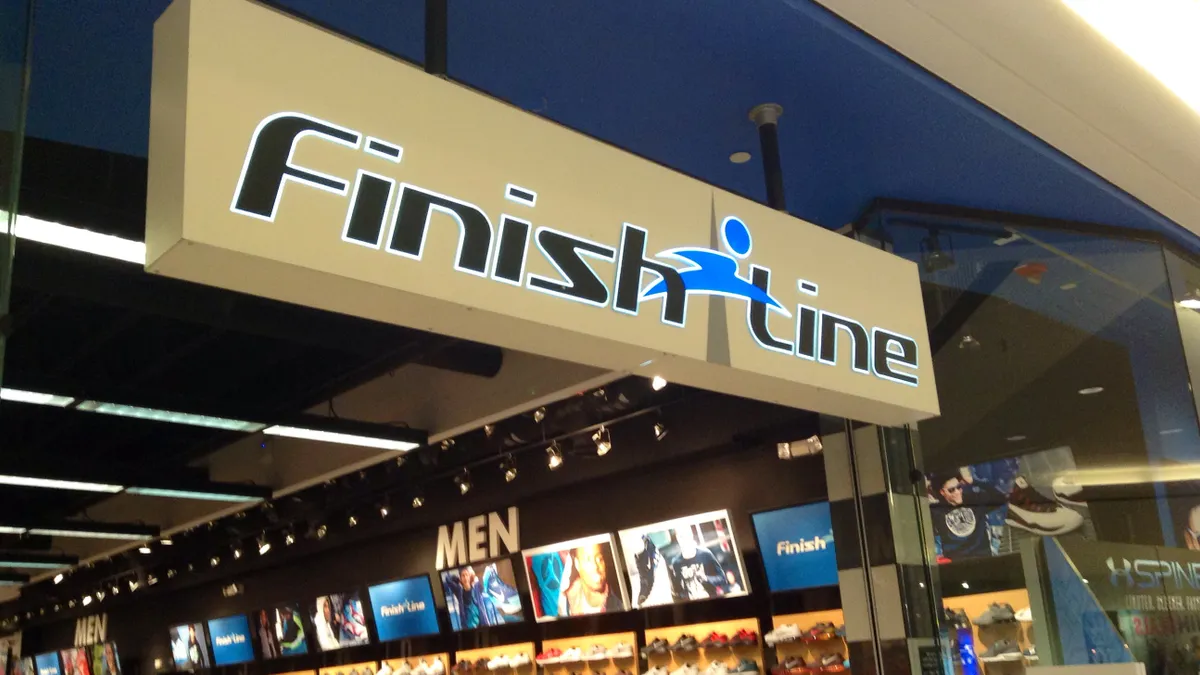Dive Brief:
-
Shares of Finish Line sank as much as 20% Friday after the athletic apparel retailer released a quarterly and full-year report that missed expectations.
-
Finish Line's Q4 consolidated net sales fell 0.4% to $557.5 million, beating the FactSet expectation for $548.1 million cited by MarketWatch, but Q4 same-store sales fell 4.5%, compared to FactSet’s forecast for a 4.2% decline. The company generated a loss of $9.47 million or 23 cents per share, from a profit of $4.0 million or 9 cents per share in the year-ago period. In good news for both Finish Line and Macy’s, sales at the department store rose 35% in Q4, and for the full fiscal year 2017, Finish Line said that consolidated net sales rose 2.5% $1.84 billion, with same-store sales increasing 0.3% and sales at Macy’s up nearly 30%.
-
In a conference call with analysts, CEO Sam Sato said Finish Line shuttered 24 underperforming stores in fiscal 2017, bringing the total number of closures to 78 over the last 24 months, and that the company has identified and plans to close another 15 to 20 locations this year, according to a transcript from Seeking Alpha.
Dive Insight:
Much of Finish Line’s profits evaporated in the fourth quarter as the retailer was forced into massive discounts to move inventory, Sato said in a statement Friday, though the loss line was exacerbated by one-time charges related to the January sale of its JackRabbit business to CriticalPoint Capital for $0.
Finish Line executives attempted to perform damage control by emphasizing the company’s efforts to update its stores and shutter under-performing locations. “We debuted our newest store format between a bold and modernized the design talent including a complete refresh of the Finish Line logo, store front, floor, fixture and shoe walls. Following the successful checks of 15 stores, including eight in the Chicago area, during the second quarter we expanded the program with a focus on key strategic markets across the country,” Sato told analysts. “[W]e updated 42 stores in fiscal 2017 with the new design and remain on schedule to touch the significant portion of the fleet over the next several years. As we got further along in the process we gained greater efficiencies in executing a remodel allowing us to lower the overall costs per location.”
The approach is sound, but the implementation has been somewhat off, according to GlobalData Retail managing director Neil Saunders, who also said that the forced discounts are unfortunate, considering Finish Line's efforts to improve its inventory.
“The merchandise mix is disappointing given the work Finish Line has put into collaborating with its brand partners to develop an on-trend product,” Saunders said in an email to Retail Dive. “Higher profile marketing and the refurbishment of some stores accompanied these efforts, and are all designed to improve the image of Finish Line and allow it to support higher price points. These latest results suggest that the strategy is not yet optimized and that Finish Line has much more work to do in shifting its brand perception. All that noted, we do not believe that the strategic direction Finish Line is taking is wrong; we just believe that execution has been sub-optimal.”
Finish Line’s refurbished stores are doing better, Saunders added, “which indicates that there is some hope for the changes being made.”
And while the retailer’s Macy’s concessions provided a ray of sunshine in its quarterly and full-year results (with sales of kids and youth sizes in line with the department store’s older, more family-oriented demographic, and with little risk of cannibalization, according to GlobalData), Saunders warned that ongoing Macy’s closures, expected to reach 100 in coming months and possibly more, could hurt Finish Line. “As such, getting stand-alone stores into strong, sustainable growth territory is now a matter of priority,” Saunders said.















